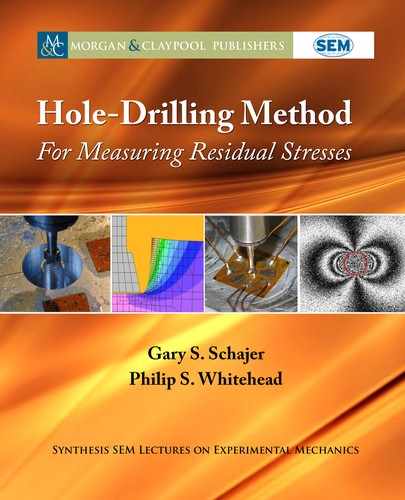
150 7. OPTICAL TECHNIQUES
e relationship between the surface deformations and the resulting ESPI phase changes
depends on the particular optical geometry used. For the arrangement shown in Figure 7.5, the
sensitivity direction lies along the blue vector “k” that bisects the directions of the illumination
and object beams. An ESPI setup with similar geometry to that used for the Moiré interferom-
eter shown in Figure 7.3 would have in-plane sensitivity. When used for ESPI measurements,
a diffraction grating would not be needed on the specimen surface. Both the out-of-plane ge-
ometry shown in Figure 7.5 and the in-plane geometry shown in Figure 7.3 are suitable for
hole-drilling applications.
A significant feature of ESPI is that it can work with a plain specimen surface, without
attachment of the diffraction grating needed for Moiré measurements. is makes it possible to
do ESPI measurements rapidly, thus making it suitable as an industrial quality control tool. As
with all the optical methods, ESPI equipment is more complex and expensive compared with
strain gauge equipment, but the per-measurement cost can be significantly lower. Figure 7.7
shows examples of ESPI devices suitable for industrial use.
(a) (b)
Figure 7.7: Example ESPI equipment suitable for industrial use. (a) Radial interferometer (A.
Albertazzi and M. Viotti) and (b) PRISM system (Stresstech Oy).
7.5 DIGITAL IMAGE CORRELATION
Digital Image Correlation (DIC) is a versatile general-purpose optical technique used for mea-
suring surface displacements in two or three dimensions. Figure 7.8a schematically shows a typ-
ical arrangement used for 2-D (in-plane) displacement measurements. e experimental pro-
cedure involves painting a textured pattern on the specimen surface and imaging the region
of interest using a high-resolution digital camera. e camera, which is set perpendicular to
the surface, records images of the textured surface before and after deformation. e local de-

7.5. DIGITAL IMAGE CORRELATION 151
tails within the two images are then mathematically correlated, and their relative displacements
determined. e algorithms used for doing this have become quite sophisticated, and with a
well-calibrated optical system, displacements of C= 0.02 pixel can be resolved.
e 3-D technique, schematically illustrated in Figure 7.8b, involves imaging the region
of interest with two cameras and using stereoscopic imaging to determine deformations in three
dimensions. e equipment is more complex than for the 2-D technique, and careful setup
and calibration are required. For hole-drilling measurements the out-of-plane displacements
are small compared with the in-plane displacements, so in this case the extra data available from
3-D measurements provide only modest advantage.
(a) (b)
Y
X
Z
Y
X
Z
Camera
Came
r
a
Camera
Figure 7.8: Typical DIC measurement arrangements, (a) 2-D and (b) 3-D.
e DIC method has both advantages and disadvantages compared with the interferomet-
ric methods. Its major disadvantage is its relatively low sensitivity, about an order of magnitude
less when measuring a typical 2 mm diameter hole. It also requires the painting of a speckle
pattern on the specimen surface. However, once the pattern has been applied, the surface is
quite durable and can be cleaned if it becomes dirty. By comparison, a surface for ESPI mea-
surements cannot be touched at all; even very minor abrasions will damage measurement quality.
In addition, DIC can directly evaluate displacements in two in-plane directions, also the out-
of-plane direction if the 3-D technique is used. e large amount of available data improves the
quality of the resulting residual stress evaluation. By comparison, typical ESPI systems provide
displacement data in only one direction. Multi-axis ESPI systems do exist, but are uncommon.
DIC measurements differ in a very significant conceptual way from interferometric mea-
surements. Interferometric measurements are size dependent, with spatial sensitivity defined
relative to the wavelength of the light source used. In contrast, DIC is size independent because
its sensitivity depends only on the pixel density of the imaged area, not on the physical dimen-
sions represented within the image. A drilled hole could be large or small, but its appearance
within a measured image is the same. us, the DIC analysis procedure is the same. Conse-
quently, DIC is an attractive choice for hole-drilling measurements where the hole size is either
..................Content has been hidden....................
You can't read the all page of ebook, please click here login for view all page.
